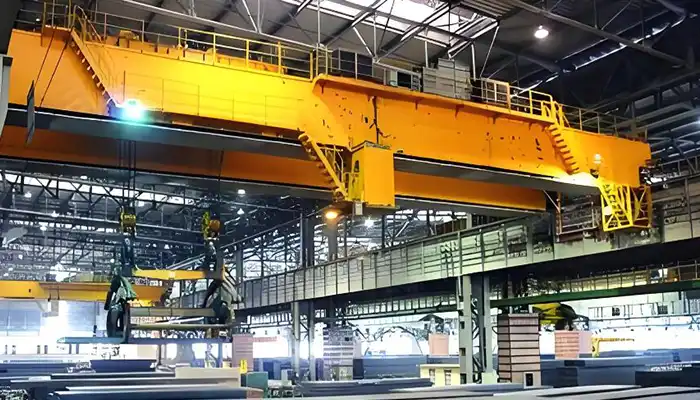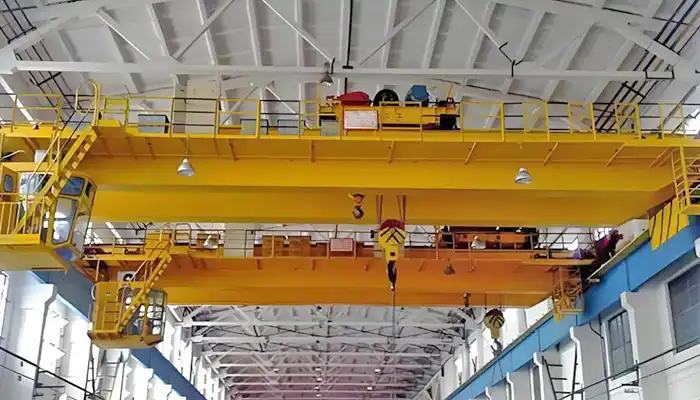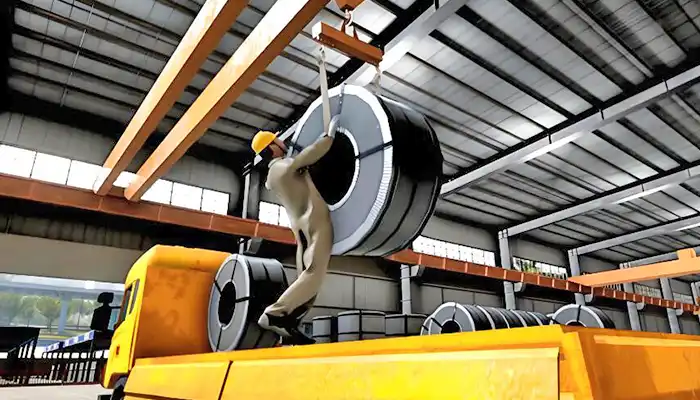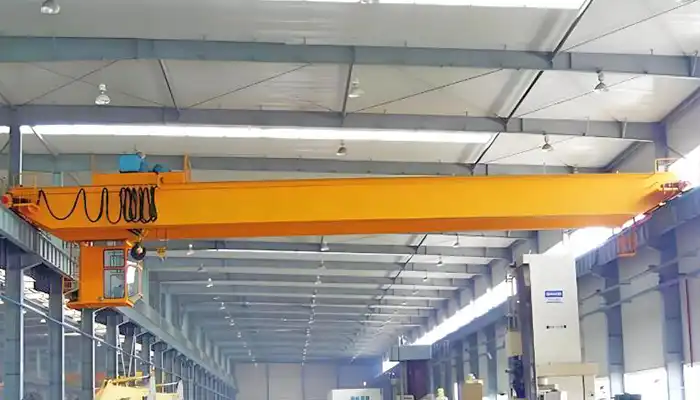Top Running Double Girder Bridge Cranes for the Steel Industry
Top running double girder bridge cranes excel in the steel industry, efficiently handling heavy loads with precise control and reliability. Get your top running crane design.Top Running Double Girder Bridge Cranes for the Steel Industry: Handling Heavy Loads with Precision
Double girder bridge cranes are robust industrial tools designed for handling heavy loads with precision and reliability. Unlike their single girder counterparts, these cranes feature two parallel girders atop which the hoisting mechanism travels, providing enhanced stability and lifting capacity. In the steel industry, where efficiency and accuracy are paramount, double girder cranes play a crucial role in facilitating the movement of raw materials and finished products throughout various stages of production.
The steel industry relies heavily on the seamless integration of heavy machinery to maintain operational efficiency and meet stringent quality standards. Double girder bridge cranes excel in this environment by offering superior load-bearing capabilities and extended spans, allowing them to effortlessly lift and transport substantial loads such as scrap metal, coils, and steel beams.

Basics of Top Running Double Girder Bridge Cranes
Definition and Basic Components
Double girder bridge cranes are industrial overhead cranes characterized by their dual beam (girder) structure that spans across the width of the workspace. These cranes are typically used in environments requiring robust lifting capabilities and extended reach. The primary components include:
- Girders:Two parallel beams that support the hoisting mechanism and trolley.
- Hoist:A lifting mechanism attached to the trolley, used for vertical lifting of loads.
- Trolley:Moves horizontally along the girders, enabling precise positioning of the hoist.
- End trucks:Support the girders and facilitate movement along the runway beams.
- Runway beams:Provide the horizontal path on which the crane travels.
Key Differences from Single Girder Cranes
Compared to single girder cranes, which have a single beam structure, double girder cranes offer several distinct advantages:
- Higher Load Capacity:The dual girder design allows for heavier lifting capacities, making them ideal for handling large and bulky loads commonly found in the steel industry.
- Increased Stability:Two girders provide greater stability and reduce sway during lifting operations, ensuring safer and more precise material handling.
- Longer Span Capability:Double girder cranes can span longer distances between runways, accommodating larger work areas and enabling efficient coverage of expansive manufacturing facilities.
Advantages in Handling Heavy Loads and Long Spans
In the demanding environment of the steel industry, where materials such as scrap metal, coils, and steel beams must be handled with precision and efficiency, double girder bridge cranes offer significant advantages:
- Enhanced Load Capacity:Capable of lifting heavier loads than single girder cranes, double girder cranes are essential for moving dense materials and oversized components.
- Extended Reach:With their ability to span longer distances, these cranes provide unrestricted movement across vast areas of steel manufacturing facilities, facilitating seamless material flow and operational continuity.
- Improved Safety:The dual girder structure enhances stability and reduces the risk of load sway, ensuring safe handling of valuable and heavy materials.
In summary, double girder bridge cranes are indispensable tools in the steel industry, providing robust lifting capabilities, enhanced stability, and the flexibility to operate over extended spans. Their structural design and operational advantages make them a preferred choice for manufacturers seeking efficient and reliable solutions for handling heavy loads and navigating large-scale production environments.
Design Features and Capabilities
Structural Components: Girders, Trolleys, Hoists
Double girder bridge cranes are designed with several key structural components that contribute to their robust performance and versatility in the steel industry:
- Girders:The dual girder configuration forms the primary framework of the crane, providing stability and support for heavy loads. Made from high-strength steel, these girders are engineered to withstand the rigors of continuous operation and the weight of substantial materials.
- Trolleys:Mounted on the girders, the trolley houses the hoisting mechanism and facilitates horizontal movement along the length of the crane. This allows for precise positioning of the hoist and efficient loading and unloading of materials across the workspace.
- Hoists:Integral to the lifting process, hoists are responsible for raising and lowering loads vertically. They are equipped with robust motors and braking systems designed to handle heavy capacities safely and efficiently. Hoists can be customized with various lifting speeds and configurations to meet specific operational requirements in the steel industry.
 Open winch trolley double girder top running bridge cranes
Open winch trolley double girder top running bridge cranes
Load Capacities and Lifting Heights
Double girder bridge cranes are renowned for their impressive load capacities and lifting heights, making them indispensable for handling heavy materials and accommodating large-scale manufacturing operations:
- Load Capacities:These cranes can lift loads ranging from a few tons to several hundred tons, depending on the specific model and configuration. This capability ensures that they can handle a wide range of materials, including steel coils, beams, and other heavy components commonly found in steel production facilities.
- Lifting Heights:Designed to operate in facilities with varying ceiling heights, double girder cranes offer substantial lifting heights. They can efficiently lift materials to elevated storage areas, loading docks, or other designated locations within the facility, optimizing vertical space utilization and enhancing workflow efficiency.
Customization Options for Steel Industry Needs
Manufacturers of double girder bridge cranes understand the diverse requirements of the steel industry and offer customization options to tailor cranes to specific operational needs:
- Control Systems:Advanced control systems enable precise handling and integration with existing manufacturing processes. Options include pendant controls for manual operation or radio remote controls for increased operator mobility and visibility.
- Environmental Considerations:Cranes can be equipped with features such as specialized coatings or insulation to withstand harsh environmental conditions commonly found in steel mills, including high temperatures, humidity, and airborne contaminants.
- Auxiliary Equipment:Additional equipment, such as magnet attachments for handling ferrous materials or special lifting devices for irregularly shaped loads, can be integrated to enhance crane functionality and versatility in steel manufacturing applications.
In conclusion, the design features and capabilities of double girder bridge cranes make them well-suited for the demanding requirements of the steel industry. From their robust structural components to their customizable configurations, these cranes are engineered to optimize material handling efficiency, enhance safety, and support the seamless operation of steel manufacturing facilities.
Applications in the Steel Industry
Double girder bridge cranes play a crucial role in various aspects of steel manufacturing, facilitating efficient material handling and supporting seamless production processes:
Handling Raw Materials
In steel production facilities, the efficient handling of raw materials is essential for maintaining operational continuity and optimizing manufacturing processes. Double girder bridge cranes are utilized for:
- Scrap Metal Handling:These cranes excel in the retrieval, transportation, and positioning of scrap metal, which is a primary raw material in steel production. Their robust design and high load capacity make them capable of lifting heavy scrap metal materials from storage areas or delivery trucks to processing stations.
- Coil Handling:Steel coils are critical components used in the production of various steel products. Double girder cranes are employed to safely lift, transport, and position steel coils within the manufacturing facility. Their precise control systems ensure that coils can be maneuvered with accuracy, minimizing the risk of damage during handling.
 top running double girder bridge crane for steel coil handling
top running double girder bridge crane for steel coil handling Transporting Finished Products
Once steel products are manufactured, double girder bridge cranes facilitate their efficient movement throughout the facility, ensuring timely delivery to storage or shipping areas. Common applications include:
- Steel Beam Handling:Large and heavy steel beams require specialized equipment for safe and efficient handling. Double girder cranes with high load capacities and extended spans are used to transport steel beams from fabrication areas to storage yards or loading docks.
- Steel Plate Transport:Double girder cranes are capable of lifting and transporting steel plates of various sizes and weights. They ensure precise positioning and smooth transfer of steel plates between manufacturing processes, such as cutting, forming, and welding stations.
Integration with Steel Manufacturing Processes
Double girder bridge cranes are seamlessly integrated into diverse steel manufacturing processes to enhance productivity and operational efficiency:
- Production Line Support:These cranes provide essential support to production lines by delivering raw materials, transferring work-in-progress components, and removing finished products. Their versatility allows them to adapt to the dynamic demands of continuous manufacturing operations.
- Storage and Retrieval:Cranes play a pivotal role in the storage and retrieval of steel materials and products within warehouses and storage yards. They enable efficient inventory management and ensure that materials are readily accessible for production and shipment.
- Maintenance and Overhaul:Double girder cranes are also utilized for maintenance activities, such as lifting and replacing heavy machinery components or performing inspections at elevated heights. Their robust construction and precise control systems contribute to safe and effective maintenance operations.
In summary, double girder bridge cranes are indispensable tools in the steel industry, supporting a wide range of applications from handling raw materials to transporting finished products and integrating seamlessly into various manufacturing processes. Their versatility, high load capacities, and precision make them essential for optimizing material flow, enhancing operational efficiency, and ensuring the smooth operation of steel manufacturing facilities.
Benefits of Double Girder Cranes
Double girder bridge cranes offer several key benefits that make them indispensable in the steel industry, where efficiency, safety, and reliability are paramount:
Enhanced Load Capacity and Stability
- Higher Load Capacity:Double girder cranes are designed to handle heavier loads compared to single girder cranes, making them ideal for lifting dense materials such as steel coils, beams, and plates. The dual girder structure distributes the load more evenly, reducing stress on the crane components and enhancing overall lifting capacity.
- Greater Stability:The dual girder design provides increased stability during lifting and movement operations. This stability minimizes load sway and ensures precise positioning of materials, even when operating at maximum capacities. As a result, double girder cranes offer a safer and more controlled handling environment for heavy and valuable steel products.
Improved Lifting Height and Precision
- Extended Lifting Height:Double girder cranes are capable of reaching higher elevations than single girder cranes, thanks to their robust structural design and enhanced lifting capabilities. This capability is crucial in steel manufacturing facilities where materials need to be lifted to elevated storage areas or loaded onto trucks for shipment.
- Precision Handling:Advanced control systems and precise trolley movements enable operators to maneuver loads with accuracy and efficiency. This precision is essential for aligning materials during manufacturing processes, minimizing material waste, and optimizing production throughput.
Safety Features and Operational Efficiency
- Safety:Double girder cranes are equipped with advanced safety features to protect both operators and equipment. These may include overload protection systems, emergency stop buttons, limit switches to prevent over-travel, and redundant braking systems. These safety measures ensure compliance with industry regulations and promote a secure working environment.
- Operational Efficiency:The robust design and high-performance capabilities of double girder cranes contribute to improved operational efficiency in steel manufacturing. They facilitate faster cycle times, reduced downtime for maintenance, and seamless integration into production workflows. This efficiency translates into cost savings and enhanced overall productivity for steel producers.
In summary, double girder bridge cranes offer substantial benefits to the steel industry, including enhanced load capacity and stability, improved lifting height and precision, and comprehensive safety features. These advantages make them indispensable tools for handling heavy materials, optimizing material flow, and maintaining high standards of operational efficiency in steel manufacturing facilities.
Considerations for Steel Industry Users
Steel industry users considering the implementation of double girder bridge cranes should take into account several critical factors to ensure optimal performance, safety, and cost-effectiveness:
Maintenance Requirements and Downtime
- Regular Maintenance:Double girder cranes require routine maintenance to ensure continuous operation and longevity. This includes inspections of structural components, hoists, trolleys, and electrical systems to detect and address potential issues early.
- Scheduled Downtime:Planned maintenance schedules should be established to minimize unplanned downtime. This ensures that maintenance activities, such as lubrication, component replacements, and safety inspections, are conducted without disrupting production schedules.
Operational Costs and Return on Investment (ROI)
- Initial Investment:The cost of acquiring and installing double girder cranes is a significant consideration for steel manufacturers. Factors influencing cost include crane capacity, span length, customization options, and installation requirements.
- Operational Efficiency:Evaluate how double girder cranes contribute to operational efficiency, such as reducing material handling times, optimizing workflow, and improving production throughput. Calculate potential cost savings derived from enhanced productivity and reduced labor costs.
- Return on Investment (ROI):Assess the expected ROI based on factors like increased production capacity, reduced downtime, improved safety, and extended equipment lifespan. Consider the long-term benefits of investing in durable, high-performance cranes that support sustainable growth and profitability.
Training and Safety Protocols for Crane Operators
- Operator Training:Proper training is essential for crane operators to safely and effectively operate double girder cranes. Training programs should cover crane operation, safety protocols, load handling techniques, emergency procedures, and equipment maintenance.
- Safety Protocols:Implement comprehensive safety protocols to mitigate risks associated with crane operations. This includes conducting pre-operational checks, adhering to load capacity limits, using personal protective equipment (PPE), and maintaining clear communication during lifting operations.
- Continuous Improvement:Foster a culture of safety through regular training updates, safety audits, and incident reviews. Encourage operators to report safety concerns and provide feedback on operational practices to enhance safety awareness and compliance.
By carefully considering maintenance requirements, operational costs, ROI, and safety protocols, steel industry users can make informed decisions regarding the implementation and utilization of double girder bridge cranes. These considerations ensure that cranes are effectively integrated into manufacturing processes, maximize operational efficiency, and promote a safe working environment for all personnel involved.
 Electric hoist top running double girder bridge crane
Electric hoist top running double girder bridge crane
Case Studies and Real-World Examples
Case Study 1: Use of Double Girder Cranes in a Steel Foundry
In a bustling steel foundry, the efficient handling of raw materials and molten metal is crucial for maintaining production schedules and ensuring operational efficiency. A double girder bridge crane was installed to meet these demanding requirements, offering robust capabilities tailored to the foundry's unique operational needs:
- Challenge:The foundry faced challenges in handling heavy ladles of molten metal and transporting raw materials such as scrap metal and ingots across various processing stations within the facility.
- Solution:A custom-designed double girder crane with a high load capacity and extended span was installed. The crane's dual girder structure provided enhanced stability and lifting capacity, allowing it to safely maneuver heavy ladles weighing several tons and transport bulky raw materials with precision.
- Benefits:The implementation of the double girder crane resulted in several operational benefits:
- Improved Efficiency:Reduced material handling times and increased throughput due to the crane's ability to swiftly transport and position materials at different stages of production.
- Enhanced Safety:Enhanced safety features, including overload protection and precise control systems, ensured safe operations during the handling of molten metal and heavy loads.
- Cost Savings:Reduced labor costs and minimized downtime through efficient material handling and optimized workflow processes.
This case study highlights how double girder cranes can address specific challenges in steel foundries by enhancing operational efficiency, ensuring safety, and supporting continuous production processes.
Case Study 2: Implementation in a Steel Rolling Mill
In a steel rolling mill tasked with producing high-quality steel plates and coils, the reliable handling of finished products and efficient material flow are critical for meeting customer demands and maintaining competitive advantage. A double girder bridge crane was strategically deployed to optimize these processes:
- Challenge:The rolling mill required a robust material handling solution capable of lifting and transporting heavy steel coils and plates across expansive production areas and storage yards.
- Solution:A double girder crane with a customized lifting capacity and span length was integrated into the mill's operations. The crane's dual girder design provided the necessary strength and stability to handle large steel coils weighing several tons and facilitate smooth movement throughout the facility.
- Benefits:The implementation of the double girder crane delivered significant benefits to the steel rolling mill:
- Increased Productivity:Accelerated material handling and seamless integration with production lines resulted in improved throughput and reduced cycle times.
- Versatility:The crane's ability to handle a variety of steel products, including coils and plates of different sizes and weights, enhanced operational flexibility and adaptability.
- Operational Efficiency:Reduced operational costs and enhanced resource utilization through efficient material flow and optimized space utilization in storage areas.
By leveraging the capabilities of double girder cranes, this steel rolling mill achieved operational excellence, improved product quality, and maintained a competitive edge in the highly competitive steel manufacturing industry.
These case studies underscore the versatility and effectiveness of double girder bridge cranes in addressing specific challenges and optimizing operations in diverse segments of the steel industry. Whether in foundries handling molten metal or rolling mills producing steel products, these cranes play a pivotal role in enhancing productivity, ensuring safety, and driving overall operational efficiency.
 Ladle overhead crane , top running double girder bridge cranes
Ladle overhead crane , top running double girder bridge cranes
FAQs of Top Running Double Girder Bridge Crane for Steel Industry
Common Questions about Double Girder Bridge Cranes in the Steel Industry
1. What are double girder bridge cranes and how do they differ from single girder cranes?
Double girder bridge cranes feature two parallel girders atop which the hoisting mechanism travels, offering higher load capacities and extended spans compared to single girder cranes. This dual girder design enhances stability and allows for precise handling of heavy materials commonly found in steel manufacturing.
2. What are the primary applications of double girder bridge cranes in the steel industry?
Double girder cranes are used extensively in the steel industry for handling raw materials such as scrap metal and coils, as well as transporting finished products like steel beams and plates. They integrate seamlessly into production processes, supporting efficient material flow and enhancing operational productivity.
3. What are the key benefits of using double girder bridge cranes in steel manufacturing?
The benefits include enhanced load capacity and stability, improved lifting height and precision, and comprehensive safety features. These cranes optimize material handling efficiency, reduce operational costs, and ensure a safe working environment for crane operators and personnel.
4. How can double girder bridge cranes contribute to improving safety in steel manufacturing facilities?
Double girder cranes are equipped with advanced safety features such as overload protection systems, emergency stop buttons, and precise control mechanisms. These features minimize risks associated with heavy lifting and ensure safe operation during material handling activities.
5. What customization options are available for double girder bridge cranes to meet specific needs in the steel industry?
Double girder cranes can be customized with various control systems, lifting capacities, and specialized attachments to accommodate specific operational requirements. Options include radio remote controls, special coatings for environmental protection, and auxiliary equipment for handling unique steel products.
6. What is the expected return on investment (ROI) for implementing double girder bridge cranes in steel manufacturing?
Implementing double girder cranes can lead to increased productivity, reduced downtime, and enhanced operational efficiency, resulting in significant cost savings over time. The ROI is influenced by factors such as improved material handling capabilities, optimized workflow processes, and extended equipment lifespan.
These FAQs provide concise answers based on the benefits and applications of double girder bridge cranes in the steel industry, offering insights into how these cranes can optimize operations and support sustainable growth in steel manufacturing facilities.
Conclusion
In conclusion, double girder bridge cranes stand as indispensable assets in the steel industry, offering a multitude of benefits that enhance efficiency, safety, and overall operational performance. Throughout this article, we have explored the robust design features, diverse applications, and significant advantages that these cranes bring to steel manufacturing facilities.
Double girder bridge cranes excel in handling heavy loads with precision and stability. Their dual girder structure supports higher load capacities and extended lifting heights, making them ideal for transporting raw materials like scrap metal and coils, as well as finished products such as steel beams and plates. These cranes integrate seamlessly into steel manufacturing processes, contributing to improved productivity, reduced downtime, and enhanced safety for operators and materials alike.
Are you considering upgrading your material handling capabilities? Whether you're looking to enhance productivity, improve safety standards, or optimize operational efficiency, double girder bridge cranes offer tailored solutions to meet your specific needs. Contact us today to explore how our expertise in crane design and manufacturing can support your goals in the steel industry. Let's work together to elevate your operations with reliable, high-performance crane solutions.
In essence, double girder bridge cranes not only represent a technological advancement in material handling but also a strategic investment in the future success of steel manufacturing operations. Embrace the power of precision, reliability, and efficiency with double girder bridge cranes—your partners in driving innovation and excellence in the steel industry.




